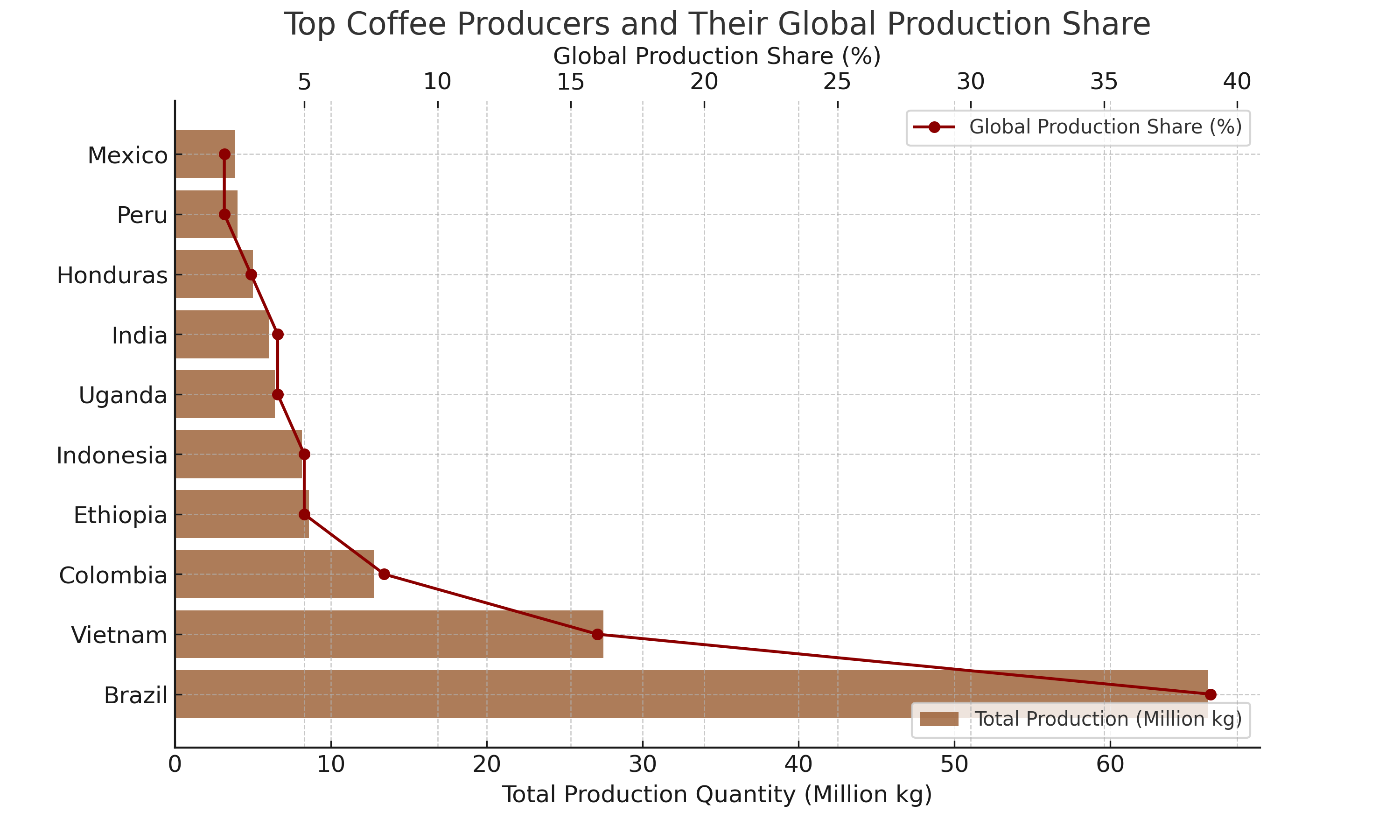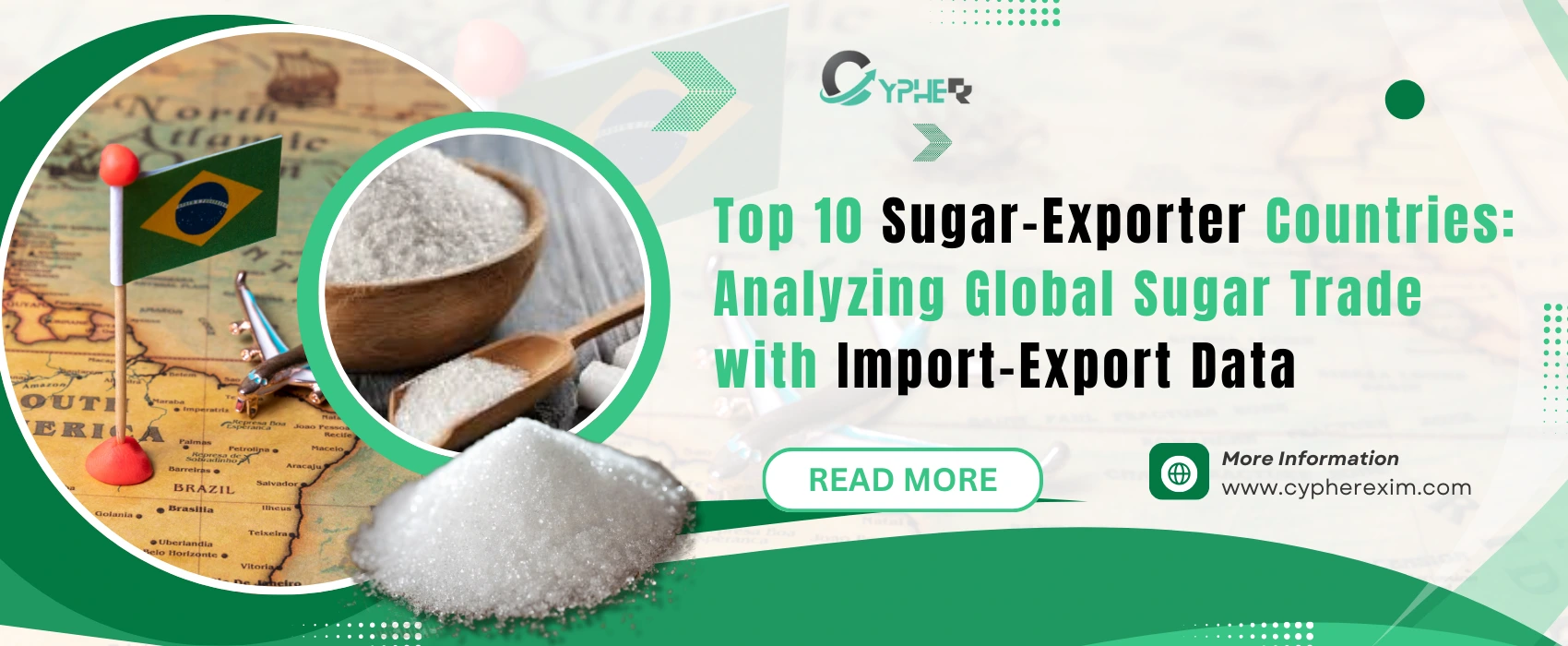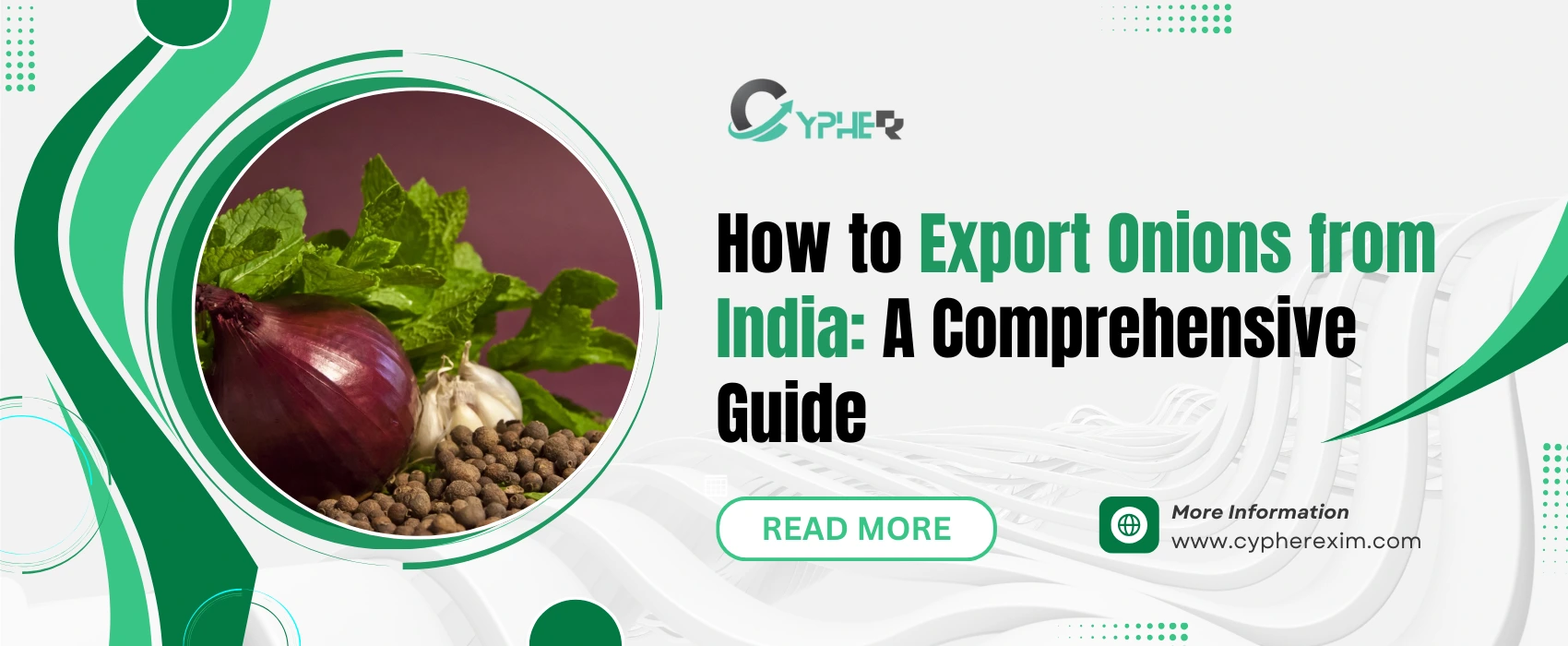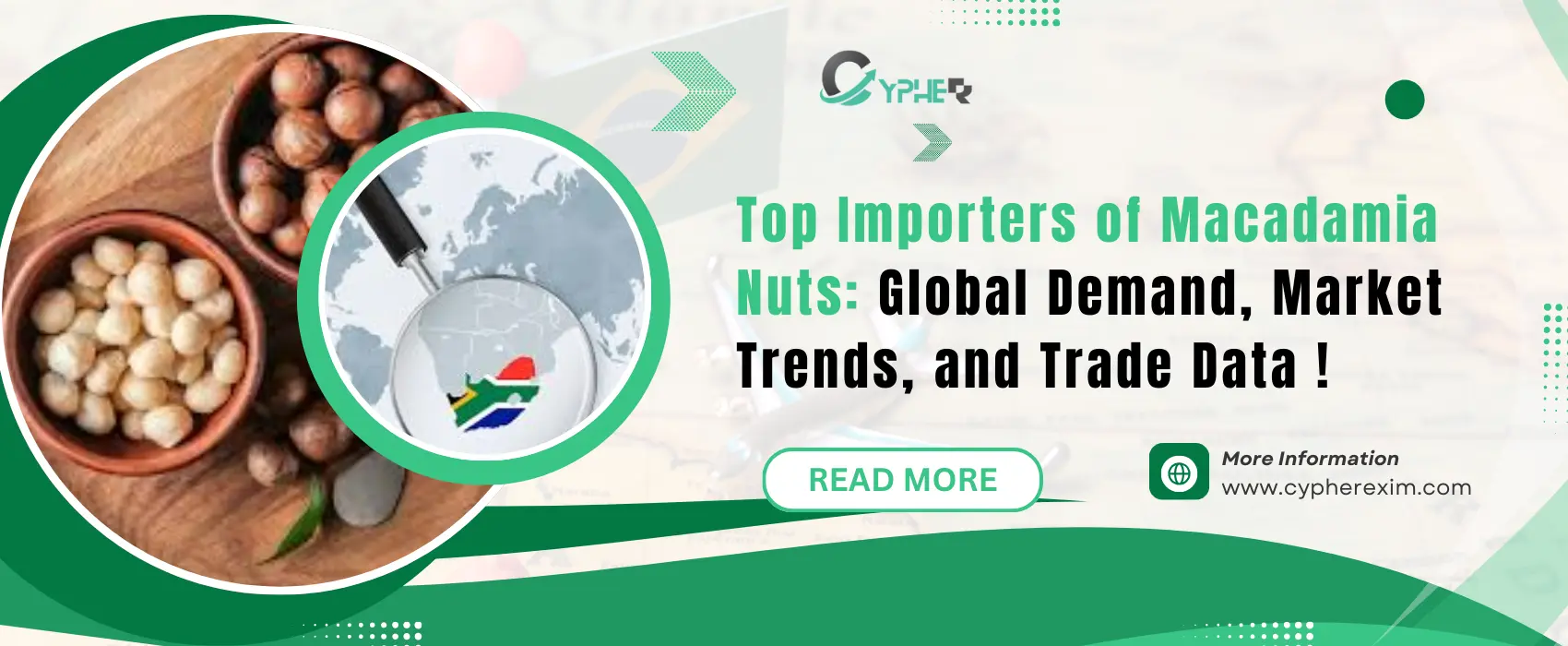Coffee Export & Import Data: Global Trade Trends & Insights

31 Mar 2025
Enjoyed daily by billions, coffee is one of the world’s most favorite beverages. From where does it originate? Coffee’s country of origin is a vital integrity of the world's industry while coffee cultivation and processing sustain millions of farmers along with factory workers. Growing the coffee beans is only the first step, then you must move on to harvesting, drying, roasting and finally grinding the beans to make the rich coffee most of us love. It is no surprise that coffee is the second most traded merchandise around the globe, this single beverage has made a mark in each economy.
All coffee-trading nations share one key trait, they are located within the Tropics. When you buy a blend or take a sip of coffee, it’s not always easy to determine its origin. However, your coffee embarks on a long journey, sourced from beans grown in Asia, Africa, and South America. The leading coffee-producing countries play a crucial role in shaping the global coffee market and economy.
According to world coffee export data and global trade data, global coffee exports reached $42.27 billion in 2023-24, reflecting a 7% decline from the previous year. The amount of international coffee exports reached 8.11 million tons, whereas coffee production globally reached 178 million kg during the same time frame. Globally coffee is traded under the 4-digit HS codes 0901 & 2101. This article presents the top 10 coffee producing countries and tries to evaluate the most recent global coffee export numbers.
Top 10 Coffee-Producing Countries: Leading Suppliers in the Global Market
The foreign trade of coffee is dominated by exporting nations Brazil, Vietnam, Colombia, and Ethiopia that have distinctive flavor outlines and growing methodologies. The lower table illustrates the importance of those countries as coffee producers and exporters in the years two thousand and twenty-four within their shipment figures presented as millions of bags each containing sixty kilograms of coffee. The focus will be given to coffee shipment figures estimated for 2026.

| Top Coffee Producers | Global production share (%) | Total Production Quantity |
|---|---|---|
| Brazil | 39% | 66.3 million kilograms |
| Vietnam | 16% | 27.5 million kilograms |
| Colombia | 8% | 12.76 million kilograms |
| Ethiopia | 5% | 8.6 million kilograms |
| Indonesia | 5% | 8.15 million kilograms |
| Uganda | 4% | 6.4 million kilograms |
| India | 4% | 6.06 million kilograms |
| Honduras | 3% | 5 million kilograms |
| Peru | 2% | 4 million kilograms |
| Mexico | 2% | 3.87 million kilograms |
Brazil – 39% of Global Coffee Production
Brazil is the world's largest coffee producer, contributing over 39% of global coffee production. Renowned for its high-quality Arabica beans, the country cultivates coffee primarily in Minas Gerais, São Paulo, and Paraná. With an average annual production of 2.68 million metric tons, Brazil has held its position as the top coffee producer and exporter for over 150 years, according to Brazil coffee export data.
Vietnam – Producing 16% of the World's Coffee Supply
Vietnam is the world's second-largest coffee producer, according to Vietnam customs export data. As per Vietnam coffee export data, coffee ranks as the country’s second-largest export after rice, with over 1.5 million metric tons exported annually. Coffee cultivation thrives in the Buôn Ma Thuột region, where it was first introduced by French colonialists in the 1800s. A leading producer of Robusta coffee beans, Vietnam experienced rapid growth after economic reforms in 1986, which opened the coffee industry to private investment, solidifying its position as the world’s second-largest coffee producer.
Colombia – Contributing 8% to Global Coffee Production
Colombia, the third-largest coffee producer globally, is renowned for its high-quality Arabica coffee, especially from the Huila region. The country produces over 760 thousand metric tons of coffee annually. Known for its smooth, mild flavor, Colombian coffee is highly prized by coffee connoisseurs worldwide.
Ethiopia – Supplying 5% of the World's Coffee
Ethiopia, often called the birthplace of coffee, is known for its diverse coffee varieties, including the highly prized Yirgacheffe and Sidamo beans. Ethiopian coffee is celebrated for its floral and fruity notes and remains a staple in the global market. Producing over 421 thousand metric tons annually, coffee plays a crucial role in Ethiopia’s economy, contributing 10% to the nation’s GDP.
Indonesia – Accounting for 5% of the World's Coffee Supply
Indonesia is a major coffee producer, primarily growing Arabica beans. The country is famous for its unique \"giling basah\" processing method, which gives its coffee a full-bodied, earthy flavor. With an annual production of over 668 thousand metric tons, Indonesia has a long coffee history dating back to the late 1600s during Dutch colonial rule. Java was the first Indonesian island to cultivate coffee, giving rise to the globally recognized term \"Java coffee.
Uganda – Contributing 4% to Global Coffee Production
Uganda is among Africa’s leading coffee producers, primarily known for its Robusta coffee. The country’s coffee industry has seen steady growth, with exports rising each year. Producing over 209,000 metric tons annually, Uganda has a long history of coffee cultivation, with generations of farmers contributing to its thriving industry.
India – Accounting for 4% of the World's Coffee Production
India has a long history of coffee production, with most of its coffee coming from the southern states of Karnataka, Kerala, and Tamil Nadu. Indian coffee is known for its bright acidity and full-bodied flavor. More than 234 thousand metric tons of coffee are produced annually in India. They replaced much of their coffee crops with tea plantations after they were severely impacted by the coffee rust disease. Nonetheless, coffee has existed in India since the 1600s, during the Mughal Empire's rule.
Honduras – Contributing 3% to Global Coffee Production
Honduras has become a key player in the global coffee industry, with exports steadily rising in recent years. The country primarily cultivates Arabica beans, grown in regions like Copán, Comayagua, and Santa Bárbara. On average, Honduras produces over 475 thousand metric tons of coffee annually.
Peru – Contributing 2% to Global Coffee Production
Peru is an emerging player in the global coffee industry, with exports rising significantly in recent years. The country primarily grows Arabica beans, cultivated in regions like Cajamarca and Amazonas, spanning the north, central belt, and south. Coffee is produced in ten distinct locations, with a rich history dating back to the 1700s. Peru’s annual coffee production exceeds 346 thousand metric tons.
Mexico – Contributing 2% to Global Coffee Production
Mexico is a key coffee producer in the Americas, with most of its coffee grown in the southern states of Chiapas and Veracruz. Known for its nutty and chocolatey flavor profiles, Mexican coffee is highly valued in global markets.
Leading Coffee Exporting Countries: Global Coffee Trade Giants
Brazil stands as the world's leading coffee exporter, generating $7.35 billion and capturing 17.4% of the global market share. Switzerland and Germany follow closely, reinforcing their strong presence in the coffee trade. Based on 2024 coffee shipment data and coffee export data by country, the top 10 coffee-exporting nations are:
- Brazil – Leading the market with $7.35 billion (17.4%)
- Switzerland – A major exporter at $3.64 billion (8.6%)
- Germany – Strong European contender with $3.40 billion (8.1%)
- Vietnam – Asia’s top coffee exporter at $3.18 billion (7.5%)
- Colombia – Renowned for premium coffee, exporting $2.91 billion (6.9%)
- Italy – A global coffee hub with $2.58 billion (6.1%)
- Honduras – A rising exporter contributing $1.48 billion (3.5%)
- Belgium – European coffee trade center with $1.30 billion (3.1%)
- France – A key player in exports, reaching $1.27 billion (3.0%)
- Ethiopia – The birthplace of coffee, exporting $1.22 billion (2.9%)
Coffee Production by Region Worldwide – 2024 Overview
In 2024, global coffee production reflects a diverse and dynamic industry. Latin America remains dominant, with Brazil, Colombia, and Honduras leading the way. Africa continues to be a key player, with Ethiopia, Kenya, and Uganda making significant contributions to the market. Meanwhile, Asia, led by Vietnam and Indonesia, continues to expand its coffee production, further strengthening its global presence.
- South America – 89.3 million kg
- Asia & Oceania – 49.9 million kg
- Africa – 20.1 million kg
- Caribbean, Central America & Mexico – 18.7 million kg
Global Coffee Production & Exports: A Decade of Trends & Insights
| Year of export & production | Total coffee exports ($) | Coffee production volume |
|---|---|---|
| 2013 | $28.59 billion | 146.8 million kilograms |
| 2014 | $31.89 billion | 149.8 million kilograms |
| 2015 | $30.37 billion | 148 million kilograms |
| 2016 | $30.27 billion | 153.9 million kilograms |
| 2017 | $32.47 billion | 158.6 million kilograms |
| 2018 | $30.54 billion | 170.3 million kilograms |
| 2019 | $29.60 billion | 168.7 million kilograms |
| 2020 | $30.73 billion | 175.8 million kilograms |
| 2021 | $36.37 billion | 168.5 million kilograms |
| 2022 | $46.39 billion | 168.2 million kilograms |
| 2023 | $42.27 billion | 178 million kilograms |
Key Takeaways from Global Coffee Export Data
- Brazil remains the top coffee exporter and producer, followed by Vietnam and Colombia, according to Brazil's coffee export data.
- Specialty coffee demand is growing globally, with Ethiopia and Guatemala seeing rising popularity and production, as reported by the USDA.
- Climate change and environmental shifts are significantly affecting coffee production and exports, as noted by the Coffee Organization.
Conclusion:
That concludes our exploration of the world’s top coffee producers — nations that have shaped the global coffee industry through tradition, innovation, and dedication. Coffee is more than just a beverage; it’s a symbol of cultural identity and economic growth for many countries. While these leading producers dominate global supply, countless others also contribute distinct flavors, aromas, and craftsmanship, making the coffee trade truly diverse and vibrant.
From the smooth richness of Colombian Arabica to the bold, earthy tones of Vietnamese Robusta, every cup tells a story of the people and regions behind it. As you enjoy your next brew, take a moment to appreciate the global effort that brings this cherished drink from farms to your cup.
For exclusive export data and the latest coffee market trends, visit Cypher Exim. Access a verified list of top coffee suppliers and exporters through our global coffee exporters database. Additionally, explore detailed trade insights with our import database and comprehensive exporter database, covering coffee export data across multiple countries. Subscribe to our services to stay informed, analyze market opportunities, and grow your business with accurate global trade intelligence.







